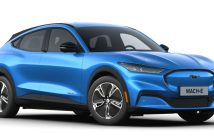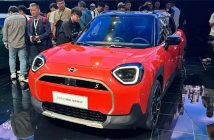+++ ALPINE will hit maximum production capacity by the end of 2023 after building on last year’s record sales figures as it continues to push to become more than just a “niche” brand. Emmanuel Al Nawakil, the French car maker’s vice president of sales and operations, said the rise in sales was down to the brand unlocking more capacity at its small Dieppe Jean Rédélé factory and it will hit maximum capacity of just over 700 cars a month at the end of the year. The increase in car sales helped the brand post further 9% year-on-year growth in the first half of 2023 (with 1.863 registrations; 159 up on the first half of 2022), driven by a record month in June (593 units), it confirmed this morning. Key to the sales hike was the success of the top-of-the-range A110 models. The A110 GT, A110 S and A110 R accounted for 77% of Alpine sales in the first half of 2023 (1.435 cars). Of those, 900 were the R. As well as this, the limited-edition A110 San Remo 73 (200 examples) and A110 R Le Mans (100 examples) were snapped up within days of being announced. The launch of new customisation options, many around special liveries, will drive this further and push the selling price of the car up, Antonino Labate, vice president of sales and marketing, said. This is a strong foundation for the car maker as it begins to expand its line-up, starting next year with the Renault 5-based Alpine A290 electric hot hatch. It will be joined by six new EVs by 2030, which, the French firm hopes, will turn it from a “niche” maker to global player. Key to this is its international growth. In the first half of 2023, the brand sold cars in 144 global locations in an undisclosed number of countries. The aim is to reach 160 by the end of 2023, particularly in Alpine’s growth markets, such as Germany (208 sales, +23% year on year). The brand is also targeting new markets such as Israel, with a showroom opened in Tel Aviv in June, and Morocco by the end of 2023. Labate said: “With almost 1.900 Alpines sold, the order book for the first 6 months of the year matches the maximum current production capacity of our Dieppe Jean Rédélé. “Alpine’s success comes from its iconic A110, which is constantly rejuvenated, and with top-of-the-range versions now accounting for 75 percent of sales. Galvanised by the A110 R Le Mans limited edition series, June 2023 registered an all-time sales record. This confirms our strategy of expanding the Alpine range, with the introduction of seven new models by 2030″. +++
+++ Early this year, CADILLAC global vice president Rory Harvey said the brand would introduce 3 new EVs before the end of December. It’s possible that China just unveiled one of them. As part of China’s Ministry of Industry and Information Technology (MIIT) process for getting vehicles to market there, the MIIT releases photos and information for a public comment period. One of the EVs recently released for public input is the Optiq. This compact crossover takes a name that parent company General Motors applied to trademark in the U.S. a couple of years ago, then abandoned, then re-applied for just this month. A search of the EU trademark office reveals GM applied to reserve the name over there just this month, on July 11. If everything lines up as I expect, the Optiq will enter various global markets under the Lyriq. It looks like a member of the family, the Lyriq’s defining traits downsized and slightly redrawn for the scale. It sits on the same BEV3 platform as the Chevrolet Equinox EV and Buick Electra twins. The Chinese ministry information lists the Optiq as having the same 295 cm wheelbase as the Equinox EV. Around the rest of the car, the China-market Optiq stands 482 cm long, 191 cm wide and 164 cm high. Compared to the coming Equinox EV, the Cadillac’s roof sits 2,5 cm higher, the other dimensions are about 2 cm apart. Compared to our Lyriq, the Optiq is about 18 cm shorter, 7 cm narrower, but again, its roof sits 2,5 cm higher. The cross-over weighs 2.170 kilos and maxes out at 180 kilometers per hour. There are 2 Optiq trims listed, separated by a 0,3 cm in roof height. Both come with a single Ultium electric motor turning one of the axles. one motor produces 204 horsepower, the other 245 horsepower. Battery capacity wasn’t disclosed. The Optiq is expected to launch in China in the latter half of this year. +++
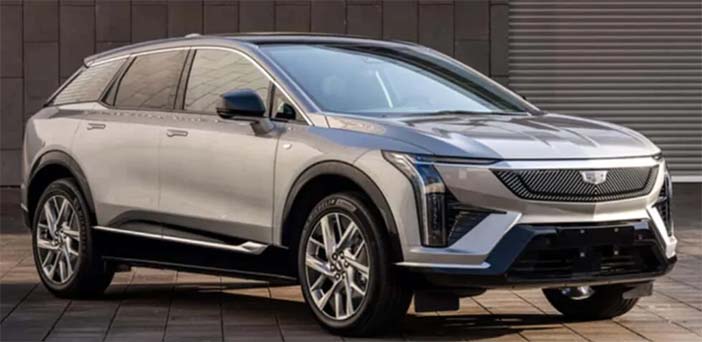
+++ After it became the automaker with the most recalls, the most recalled vehicles, and the biggest single recall in 2022, FORD vowed to address quality concerns. The fruits of that effort have yet to be felt, as the Detroit automaker has yet again topped the charts for most recalls. In the first half of the year, Ford has issued 31 recalls in the United States, 5 more than second-place Stellantis and 13 more than BMW, data from the National Highway Traffic Safety Administration (NHTSA) shows. It should hardly come as a surprise, then, that it has the most vehicles affected by such a campaign in the industry. Ford’s 31 recalls affect a total of 4.1 million vehicles, nearly twice as many as Stellantis, and nearly 4 million more than BMW. However, despite those automakers’ large volumes of recalls, Honda-Acura was the manufacturer with the second-most affected vehicles. Although it has initiated only 11 campaigns through June, they potentially impact a total of 2.8 million vehicles. Similarly, although it didn’t appear on the list of the 12 most recalled automakers in America, Tesla’s eight campaigns potentially affect a total of 366.922 vehicles. That makes it the automaker with the fifth most vehicle possibly impacted by a recall campaign. The total number of vehicles affected by a recall is not necessarily an accurate reflection of how many vehicles are driving around dangerously. The number is a gauge of how many vehicles contain a suspect part, which means that it is an inflated number, particularly for automakers that share components between vehicles. Automakers also argue that recall campaigns are a good thing, allowing them to improve safety even after a vehicle has left the factory. “Vehicle safety is of primary importance at Stellantis”, Eric Mayne, a company spokesperson, told. “Accordingly, we continuously monitor the performance of our vehicles in the field, which helps us identify potential issues in an expeditious manner”. Indeed, safety advocates agree that recalls are a valuable tool companies and regulators leverage to keep consumers safe and, to some extent, are inevitable in an imperfect world. However, a high volume of recalls can indicate a lapse in quality, and Ford says it’s looking to address that. In May, it introduced a “zero-defect launch process” at its Kentucky and Ohio assembly plants for the 2023 F-Series Super Duty pickup truck. At that plant (and elsewhere) it is introducing more quality checks on the line to help identify issues before they reach customers. “Our goal is to have best-in-class quality performance for F-150, Super Duty, Bronco and Ranger trucks and Transit vans by 2025. And to be among the leaders in all other segments”, Maria Buczkowski, a Ford spokesperson told. “Where we didn’t prevent quality issues in the first place, our obligation to customers is to detect and resolve them as quickly as possible”. +++
+++ LOTUS has revealed that the first examples of the all-electric Evija hypercar will be handed over to customers during next month’s Monterey Car Week in California. It has been 4 long years since the Evija was first unveiled and while the car manufacturer released plenty of updates about its development throughout 2020 and part of 2021, very few info has been provided about the car since then. Lotus had hoped to begin deliveries in 2020 but the Covid-19 pandemic delayed those plans. The car manufacturer’s director of Attributes and Product Integrity, Gavan Kershaw, told at the recent Goodwood Festival of Speed that the car is finally ready for prime time and that customer deliveries will commence in August. It is not yet clear when production of the hypercar started but Lotus did bring along a customer car to Goodwood, namely one of the limited-edition Evija Emerson Fittipaldi Edition models. It is believed to be heading to a customer in China. Lotus plans to build just 130 examples of the Evija for customers but interestingly, Kershaw revealed that the car has not yet sold out, meaning there’s still a chance for prospective owners to place an order. The same cannot be said about the Evija’s 2 main rivals, the Rimac Nevera and Pininfarina Battista, both of which are sold out. The Evija is driven by four electric motors that combine to produce 2.000 hp and 1.700 Nm of torque. These motors receive their juice from a 70 kWh battery pack and the British company claims it can hit 300 km/h in less than 9 seconds and exceed 320 km/h flat out. After the car’s Covid-related delays, it was hoped that deliveries could start in 2021. However, they were delayed yet again after Lotus announced it had terminated its engineering contract with Williams Advanced Engineering which had originally been tasked with developing the high-voltage systems and battery for the hypercar. +++
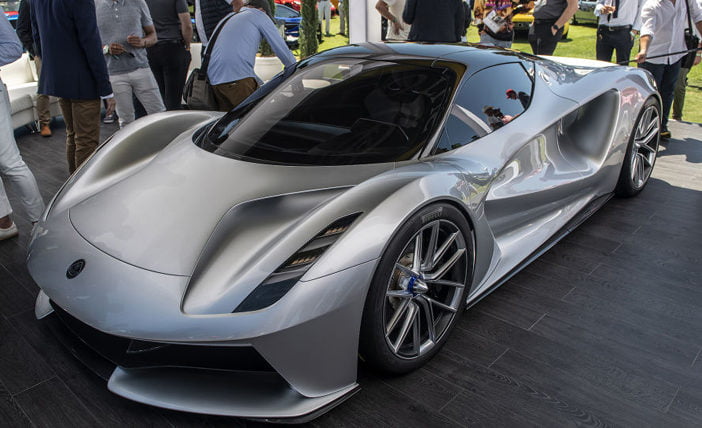
+++ MINI just dropped a teaser for its new hatchback Cooper and it’s all about the new interior. And while Mini might be calling this a teaser, it’s essentially a full, visual reveal of the new Cooper’s insides. The changes and updates are everywhere, as this new Mini shares practically nothing with the outgoing model. Its new centerpiece is a massive, circular display that appears to be showing off new infotainment system software. All of your vital information is housed within this huge screen. We can see the gear selection, electric range, power meter, navigation hub and media player all in the middle and top half of the screen. On the bottom corners are temperature control dials, and in the bottom middle is a row of shortcut icons that will presumably pull up larger menus of those items. The traditional instrument cluster is gone, but Mini has integrated a pop-up glass HUD display in its place, so you’ll thankfully still have a lot of the important items right in front of your face. Just below the center screen is what Mini calls the “toggle bar”. It houses switches and knobs for things like selecting a gear, turning the car on and off and the various drive modes. Quick toggles for the defrosters and the hazards sit here, too. Interestingly, the steering wheel has more buttons than the center console, and the steering wheel itself is a new design. You’ll notice the strap-like third bottom “spoke” of the wheel and the ultra-chunky top part of the wheel; Mini says it’s smaller in diameter than the current wheel, too. Minimalism dominates the rest of the interior. The dashboard is simple with a basic upswept look, but it’s augmented with fancy lights and animations that play through the fabric. Mini designed a horizontal air vent that integrates beautifully with the new dash, too. As for the doors, the materials look upscale and the armrest looks comfortable. We can’t see the whole center console, but a pair of USB Type-C charge ports are positioned up front with a wireless phone charger right there, too. A pair of cupholders sit aft of this, and there’s no BMW iDrive knob to be seen. +++
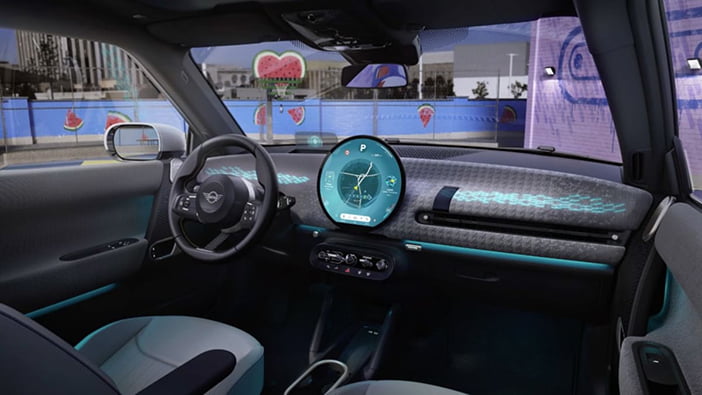
+++ While there’s little doubt that auto shows are no longer as appealing to car manufacturers as they once were, the upcoming IAA Mobility show in MUNICH in September is shaping up to have a strong collection of brands in attendance. Given that the event is held in Germany, it doesn’t come as a surprise that a host of local brands will be present. These include the likes of Audi, BMW, Mercedes-Benz, Porsche and Volkswagen. In addition, VW-owned Cupra will be at the event and is expected to show off its impressive array of models. A number of other important brands will also be in attendance, including Ford and Renault. There will also be a handful of Chinese automakers hoping to use the event to grow their presence in Europe, including BYD, Dongfeng, Hongqi, Leapmotor and Seres. The most recent inclusion to the event is Tesla. Tesla will have a presence in the open air at Munich’s Königsplatz and while visitors will be able to get up close and personal with its vehicles, it is not yet known if test drives will be available. Tesla’s attendance comes as somewhat of a surprise given that it rarely makes official appearances at auto shows. However, that doesn’t always stop the brand’s enthusiast owners as it’s not unusual for them to arrange their own gatherings on the outskirts and parking lots of auto shows. Tesla clearly views the IAA Mobility show in Munich as an important way to further expand its presence throughout the continent. Last year, the Tesla Model Y was comfortably the best-selling electric vehicle in Europe and in the first half of this year, it was the best-selling car in Europe, outselling the Dacia Sandero. +++
+++ Gird your loins, NISSAN fans. The current, 13th generation Skyline has nearly reached the end of its life cycle, and an unverified rumor claims its successor will land in 2025 as an electric crossover. The same report suggests the model could join the Infiniti range in the United States. Without citing sources, Japanese magazine Best Car wrote that Nissan initially planned to replace the Skyline (which is sold as the Infiniti Q50 in the United States) with another sedan. Development work started, but the project veered toward crossover territory and the sedan body style has reportedly been axed. Instead, the next-generation Skyline will share some of its underpinnings with the Ariya. Power will allegedly come from an evolution of the e-4ORCE drivetrain offered in the Ariya. It will consist of at least 2 electric motors for through-the-road all-wheel-drive and it could deliver over 450 horsepower. That’s more than the Ariya currently offers, and it falls in line with the Skyline nameplate’s sporty positioning. Details such as driving range, battery size, and charging times haven’t been published. Luckily, nothing suggests the decision to crossover-ize the Skyline will affect the GT-R. While the nameplate first appeared on an evolution of the third-generation Skyline released in 1968, it has been marketed as a standalone model since the current-generation car landed for 2009. I’m taking this report with a grain of salt; Best Car admits it has received “mixed information” about the Skyline’s successor and Nissan hasn’t commented on what the future holds for the nameplate. I’m not discounting the possibility that a Skyline-branded crossover will be sold alongside a Skyline-branded sedan (Toyota is taking a similar path with the Century). If the report is accurate, we’ll learn more soon. In a way, we’ve been here before. Unveiled in 2015, the Gripz concept seemingly previewed a Z-inspired crossover with a futuristic-looking design that borrowed a handful of styling cues from the 240Z. It ruffled more than a few feathers and was not approved for production. +++
+++ STELLANTIS is set to spend $11.2 billion in semiconductors through 2030 and believes that while the current chip shortage has eased, future shortages remain a possibility. The automotive conglomerate is spending an enormous sum to secure supplies for a variety of different chips for its vehicles. These include Silicon Carbide Mosfets that are vital to the range of EVs, Microcontroller Units (MCUs), a core component of the computing zones for the firm’s STLA Brain electrical architecture, and System-on-a-Chip (SoC) where performance is needed for a vehicle’s infotainment and autonomous driving assist functions. To mitigate risks of future shortages, Stellantis has inked deals with Infineon Technologies, NXP Semiconductors, and Qualcomm. The company is also establishing a semiconductor database known as Green List to reduce chip diversity and in the case of future chip shortages, to put Stellantis in control of the allocation. In addition to sourcing chips from third parties, Stellantis is working with SiliconAuto and AiMotive to develop its own semiconductors. “An effective semiconductor strategy requires a deep understanding of semiconductors and the semiconductor industry”, chief purchasing and supply chain officer at Stellantis, Maxime Picat, said. “We have hundreds of very different semiconductors in our cars. We have built a comprehensive ecosystem to mitigate the risk that one missing chip can stop our lines. At the same time, key vehicle capabilities directly depend on the innovation and performance of single devices. SiC Mosfets extend the range of our electric vehicles while the computation performance of a leading-edge SoC is essential for the customer experience and safety”. The man who oversees semiconductor purchases for Stellantis, Joachim Kahmann, said the risk of a chip shortage “will increase dramatically” over the coming years due to the growing array of vehicle software features. He added that rising tensions with China are an important factor to consider but did say that China’s restriction on the exports of gallium and germanium used in semiconductors should be manageable. +++
+++ Elon Musk’s big bet that TESLA price cuts could boost sales and profits amid increasing competition and poor economic sentiment appears to be yielding mixed results. The company beat analyst expectations for net income in the April-June quarter, although its shares barely budged. The Austin, Texas, maker of electric vehicles, solar panels and batteries reported net income of $2.7 billion in the quarter, a 20% increase from a year ago. Earnings per share also rose 20% to 78 cents when measured via generally accepted accounting principles. Analysts, however, tend to focus on Tesla’s own measurement of profit, which excludes stock-based compensation expense. By that measure, Tesla’s net income zoomed to $3.15 billion, or 91 cents a share, sharply exceeding analyst estimates of 80 cents per share according to FactSet. Analysts had expected profits to fall because of the price cuts. Total revenue rose 47% to $24.93 billion. The company reported strong vehicle delivery numbers on July 1, saying they rose 83% compared to the year-earlier quarter after the company cut prices several times on its four electric vehicle models. The company sold a record 466.140 vehicles worldwide from April through June, nearly double the 254.695 it sold during the same period a year earlier. The vast majority of the sales involved Tesla’s popular Model 3 and Model Y. But the earnings report provided mixed messages on one of the larger questions facing Tesla: whether the automaker’s discounting strategy can boost sales enough to preserve its profit margins. In particular, analysts have focused on the company’s operating profit, a measure that excludes interest and taxes. Tesla’s operating margin, which represents how efficiently sales are turned into profits, fell to 9.6% in the April-June quarter, down significantly from 14.6% a year earlier. +++
+++ VINFAST is about to take a giant leap forward in its plan to conquer the North American market. The Vietnamese automaker will start work on its $4 billion factory in North Carolina next week with the the aim of producing its first U.S.-built vehicles in 2025. The auto arm of Vingroup was founded in 2017 and announced its plans to open a U.S. factory last year. The firm is already importing Asian-built VF 8 SUVs to the U.S. but having a North American base is core to the company’s expansion plans, and could potentially help it sidestep new rules that prevent foreign-built cars qualifying for EV tax credits. VinFast was awarded a $1.2 billion incentive package from North Carolina, plus further support from city and council officials close to the 1,800-acre site at the Triangle Innovation Point in Chatham County. The firm says the state’s first EV plant is designed to produce 150.000 vehicles per year in its first phase and will generate thousands of new jobs for the area. But the fact that VinFast boasts about its flagship Hai Phong, Vietnam, plant being 90 percent automated suggests that many of the processes at the U.S. site will also be handled by machines. Let’s hope that VinFast has ironed out some of the bugs from its electric SUVs by the time the first examples start rolling off the production line two years from now, because it’s safe to say that the company hasn’t had an easy ride so far. Apart from disappointing EPA electric range figures, confusing price changes, a recall and bad press about layoffs and offering journalists money to drive its cars, VinFast has also had to endure a savaging by reviewers who collectively handed the VF 8 a real kicking, declaring it way off the pace. And it seems like buyers are paying attention to all this bad news. Only 128 VF 8 crossovers were registered in the U.S. between January and May of this year according to data from Experian, and that despite nearly 3.000 of the EVs having been shipped to the country during that time. Well, at least those 1.800 acres in North Carolina will give VinFast plenty of space to park unwanted cars. +++
+++ The VOLKSWAGEN brand’s new head of design, Andreas Mindt, doesn’t look quite like you’d expect a designer to look. Although he wears well-tailored suits, the affectations you associated with the profession (scarves, thick glasses, intimidatingly avant-garde accessories) are nowhere to be found. Instead, his dress suggests a disarming friendliness, that he hopes to bring to the vehicles he designs for the brand.An early appointment by new VW Group CEO, Oliver Blume, Mindt was brought in from Bentley as part of efforts to fix the issues that were starting to pile up for the European giant. And his revolutionary plan to fix VW design is simply to make nice cars. That may not sound radical, but it’s a stark departure from his predecessor’s mission, he told recently. Vehicles like the ID.4 and the upcoming ID.7 were designed to be obviously electric and a little bit futuristic. However, the short hoods and long windshields haven’t really landed with customers and Mindt believes that’s because they were designed for early adopters, not mass market audiences. “EVs are now 15 percent of the global market and more than 50 percent of the market in China”, said Mindt. “This is not an early adopter business anymore”. His solution is to “just calm down”. Mindt said that since VW’s electric vehicles are now being designed to appeal to the same customers whose last vehicle featured an internal combustion engine, they can use those same design principles in their EVS. The goal now is to “just make it good, make it fit and it will work”. The first evidence of this approach is the ID.2all concept. Scheduled to go on sale in 2026, the design was the result of an emergency course correction after Blume expressed his dissatisfaction with the ID.Life concept, a boxy, futuristic concept car that was set to become the ID.2. By contrast, the ID.2all has a much more conventional hatchback shape, despite its slightly futuristic headlights. And Mindt said that the concept is indicative of what he’s planning for the rest of the lineup. “I want to get this kind of stance in the whole portfolio”, said Mindt. “There was a trend for short hoods and long windshields; everyone believed this should be the design for electric cars, but it is not”. Ultimately, the designer says that he wants VW to be more like it was when he joined it in the ’90s. At the time, it was noted for making cars that felt more expensive than they were, something it has failed to deliver on lately. “This is the secret sauce. The car is better than you expect and you start to love it. Our aim is to be the love brand”, said Mindt. “We can make nice cars for nice people.” +++

